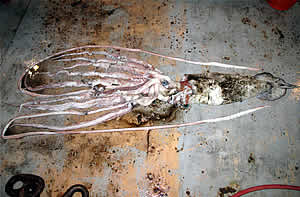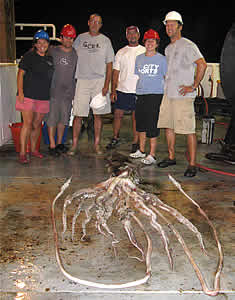
Giant squid collected by NOAA on July 30 off the Louisiana coast in the Gulf of Mexico. Credit NOAA

NOAA scientists with giant squid aboard the NOAA research vessel Gordon Gunter. Credit NOAA
Scientists from NOAA's Fisheries Service have captured a giant squid while conducting research off the Louisiana coast in the Gulf of Mexico. This is only the second known giant squid obtained from the Gulf of Mexico – the first was collected in 1954 off the Mississippi Delta where it was found floating dead at the surface.
This giant squid was collected on July 30, during a 60-day scientific study where scientists from NOAA's Southeast Fisheries Science Center and the Department of the Interior's Minerals Management Service were studying the availability and diversity of sperm whale prey. The scientists were aboard the NOAA research vessel Gordon Gunter when the squid was caught in a trawl pulled behind the research vessel at a depth of more than 1,500 feet.
"As the trawl net rose out of the water, I could see that we had something big in there…really big," said Anthony Martinez, marine mammal scientist for NOAA's Fisheries Service and chief scientist for this research cruise. "We knew there was a remote possibility of encountering a giant squid on this cruise, but it was not something we were realistically expecting."
This giant squid was preserved and sent to the Smithsonian Institution's National Museum for Natural History for further study. It measures just over 19½ feet long and weighs more than 103 pounds.
Photographs of the specimen were sent from the research vessel to squid experts at NOAA's National Systematics Laboratory, which is housed at the Smithsonian museum. Other experts at Smithsonian, the University of Miami, and Texas A&M University also confirmed the specimen was in fact a giant squid.
"This is an incredibly rare find in the Gulf of Mexico," said Dr. Michael Vecchione, director for NOAA's Fisheries Service's National Systemics Laboratory and a giant squid expert. "Giant squid have been found more commonly in areas of the world where there are deep-water fisheries, such as Spain and New Zealand, but this is the first time one has actually been captured during scientific research in the Gulf of Mexico."
According to Vecchione, scientists have known giant squid are in the Gulf because remnants of them have been found in the stomachs of predators (such as sperm whales) from Gulf waters, as well as from nearby waters of the Caribbean and Florida Keys. This find illustrates how little we know about what is swimming around in the deep waters of the Gulf of Mexico.
Giant squid are difficult to capture, but they are usually found in continental-slope areas, where the relatively shallow water near the continent drops off into the deep sea. They seem to be concentrated in places where undersea canyons cut into the slope, where they feed on fishes and other squids.
At the National Museum of Natural History, the giant squid will be archived and studied by Vecchione and other interested researchers. Vecchione noted that it will be an important addition to the worldwide study of giant squids and their biology.
NOAA understands and predicts changes in the Earth's environment, from the depths of the ocean to the surface of the sun, and conserves and manages our coastal and marine resources.
